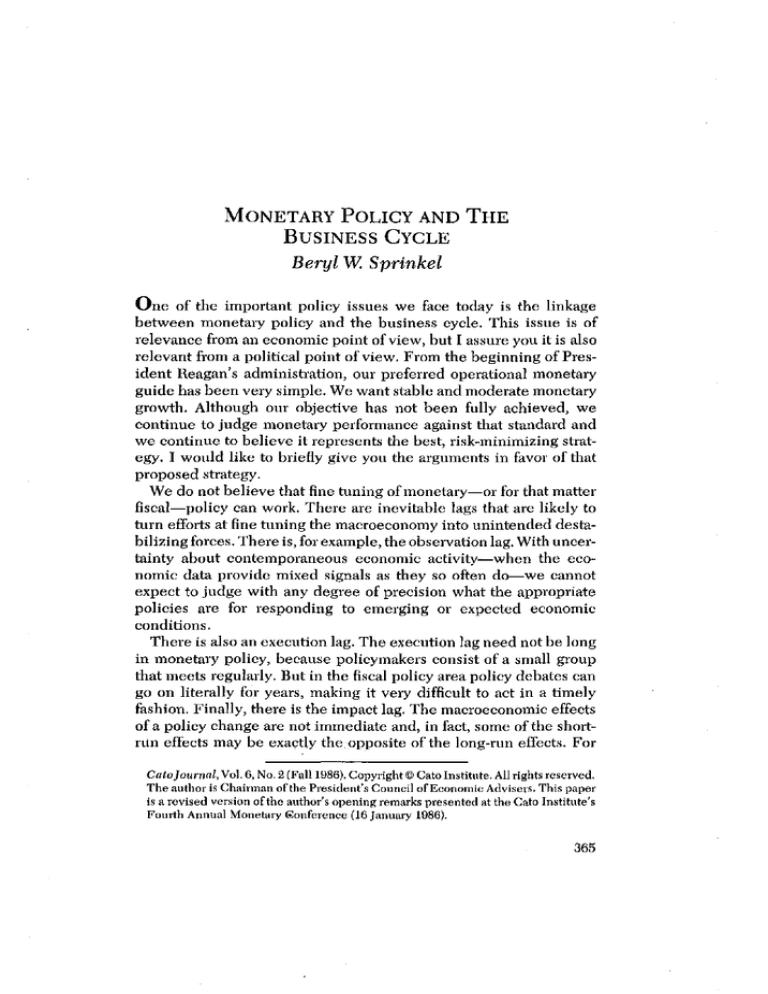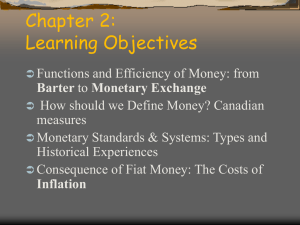
MONETARY POLICY AND
BUSINESS CYCLE
Beryl W. Sprinkel
THE
One of the important policy issues we face today is the linkage
between monetary policy and the business cycle. This issue is of
relevance from an economic point ofview, but I assure you it is also
relevant from a political point of view, From the beginning of President Reagan’s administration, our preferred operational monetary
guide has been very simple. We want stable and moderate monetary
growth. Although our objective has not been fully achieved, we
continue to judge monetary performance against that standard and
we continue to believe it represents the best, risk-minimizing strategy. I would like to briefly give you the arguments in favor of that
proposed strategy.
We do not believe that fine tuning of monetary—or for that matter
fiscal—policy can work. There are inevitable lags that arc likely to
turn efforts at fine tuning the macroeconomy into unintended destabilizing forces. There is, for example, the observation lag. With uncertainty about contemporaneous economic activity—when the economic data provide mixed signals as they so often do—we cannot
expect to judge with any degree of precision what the appropriate
policies arc for responding to emerging or expected economic
conditions.
There is also an execution lag. The execution lag need not be long
in monetary policy, because policymakers consist of a small group
that meets regularly. But in the fiscal policy area policy debates can
go on literally for years, making it very difficult to act in a timely
fashion. Finally, there is the impact lag. The macroeconomic effects
of a policy change are not immediate and, in fact, some of the shortrun effects may be exactly the opposite of the long-run effects. For
CatoJournal, Vol.6, No.2 (Fall 1986). Copyright © Cato Institute. All rights reserved.
The author is Chairman ofthe President’s Council ofEconomic Advisers, This paper
is a revised version of the author’s opening remarks presented at the Cato Institute’s
Fourth Annual Monetary conference (16 January 1986).
365
CATO JOURNAL
these reasons, I have long held that the fine tuning ofpolicy will not
work and is as likely as not to be destabilizing by inducing a stop-go
pattern to economic performance and the business cycle.
There is a fairly consistent lead-lag relationship between monetary
change and the business cycle. Although this relationship is debatable, the evidence of the direction of change between money growth
and nominal economic activity appears overwhelming. One does not
have to argue that money is the only causal factor in business cycles,
and I would not, but the evidence certainly suggests that maintaining
stable money will avoid reinforcing other inherent, cyclical initiators.
Stable and moderate monetary policy would at least not contribute
to or reinforce cyclical fluctuations, and therefore would be better
than what we typically have experienced.
Why does this administration propose moderate money growth?
Well, the answer is pretty obvious. I think that of all the hypotheses
proposed in economics, the one that may have been most widely
tested is the relation between money growth and inflation. Disagreements about how soon and how much will always occur, but there
are very few economists who would argue that the growth of monetary aggregates has no bearing on the subsequent rate of inflation.
If our objective is to achieve price-level stability, then it does
indeed matter whether we maintain moderate money growth. I assure
you that the President’s goal of achieving and maintaining pricelevel stability remains very firm, and I do my best to reinforce his
position.
Some say, well what’s wrong with inflation? Inflation always looks
relatively attractive or harmless when it is low. But we have all
learned how difficult it is to maintain just a low inflation rate. And as
inflation escalates, it becomes less and less attractive and more and
more harmful. Inflation distorts the structure of prices and profits and
causes resources to be misallocated, in addition to causing an arbitrary redistribution of income.
Because of the lack of complete price flexibility, inflation tends to
distort relative prices, thereby sending out the wrong production and
consumption signals. Furthermore, when the government defines
certain rules—such as tax codes—in monetary terms, inflation causes
very serious distortions in the economy. It can erode productive
incentives and encourage major efforts to avoid taxes. I would argue
that it unfairly redistributes income and asset values; certainly the
poor do not do well in a period of inflation nor do the holders offixedrate financialassets; Inflation promotes nonproductive activity, causes
considerable effort to be put to use to adjust portfolios, and creates
incentives for speculation. Regardless of how profitable or useful
366
MONETARY POLICY
these activities may be to an individual operating in an inflationary
environment, all such activities are a waste of society’s economic
resources, compared to an environment of price stability which would
render these activities unnecessary. Therefore, inflation essentially
limits potential real growth and impedes the improvement of living
standards. It also contributes to volatile exchange rates around the
world, thereby changing signals between tradeable and non-tradeable goods and services. This, ofcourse, inflicts costly adjustments on
societies.
Of course, inflation inevitably brings pressures to disinflate with
all the political pains and the very real economic costs that occur. I
know them only too well. In conclusion I believe achieving stable
and moderate monetary growth will go a long way toward improving
the performance of the economy. It will not, of course, solve all of
our economic problems.
From my view, I would welcome the day when the topic of this
conference—”Money, Politics, and the Business Cycle”—would
become obsolete. Not because there is no relation between money,
politics, and the business cycle; there is. But I would welcome the
day when we quit trying to use monetary policy to fine tune the
economy and, most important, when we quit expecting the Federal
Reserve to do so. The fundamental relation between money, growth
and economic activity will always be with us, but I look forward to
the possibility that we will eventually recognize the limitations of
monetary policy and cease expecting the Fed to iron out every wrinkle that develops in the economy. Then we could concentrate on
society’s real economic problems, undistorted by monetary disturbances. Money would then, indeed, be neutral.
367









